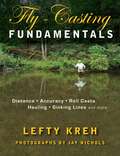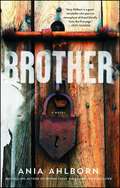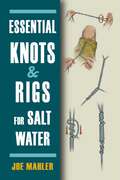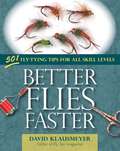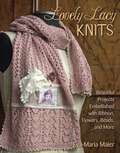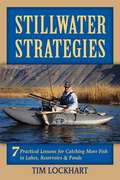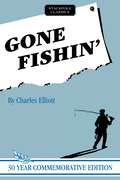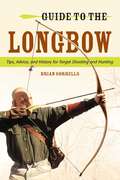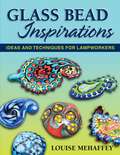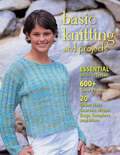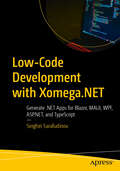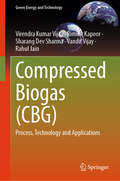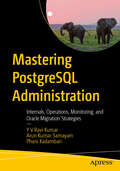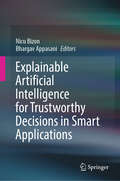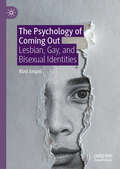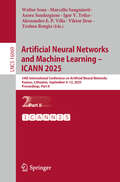- Table View
- List View
Fly-Casting Fundamentals
by Lefty KrehExpert Lefty Kreh lays the groundwork for learning to cast, including teaching and practicing tips.
Decorative Knots for Jewelry and Accessories
by Boutique-ShaLearn to tie 78 different decorative knots to create unique handmade jewelry and other accessories.How to tie beautiful Japanese, Korean, Chinese, and Celtic knots from decorative cord, hemp twine, and embroidery flossIncludes 22 projects for using the knots, plus dozens of other ideas for creative usesFull instructions and step-by-step line drawings are given for each knotKnots can be used for bracelets, necklaces, anklets, pendant settings, and other jewelry, as well as bag handles, keychains, trims, button closures, and other practical uses
Classic Michigan Flies
by Jon OsbornIncludes 16 flies from the Adams to Zoo Cougar, legendary tiers like Len Halladay, George Griffith, and Clark Lynn, and original and modern patterns for each classic fly.
Brother
by Ania AhlbornFrom the bestselling horror author of Within These Walls and The Bird Eater comes a terrifying novel that follows a teenager determined to break from his family&’s unconventional—and deeply disturbing—traditions.Deep in the heart of Appalachia stands a crooked farmhouse miles from any road. The Morrows keep to themselves, and it’s served them well so far. When girls go missing off the side of the highway, the cops don’t knock on their door. Which is a good thing, seeing as to what’s buried in the Morrows’ backyard. But nineteen-year-old Michael Morrow isn’t like the rest of his family. He doesn’t take pleasure in the screams that echo through the trees. Michael pines for normalcy, and he’s sure that someday he’ll see the world beyond West Virginia. When he meets Alice, a pretty girl working at a record shop in the small nearby town of Dahlia, he’s immediately smitten. For a moment, he nearly forgets about the monster he’s become. But his brother, Rebel, is all too eager to remind Michael of his place…
Essential Knots & Rigs for Salt Water
by Joe MahlerHandy pocket-sized guide with full-color, easy-to-follow illustrations.
Better Flies Faster
by David KlausmeyerMany books aspire to providing something for everyone ... this book actually does. --Bud Bynack, California Fly Fisher
Folded Paper German Stars
by Armin TäubnerPaper folding crafts are fun for all ages! You'll be amazed at what you can create with pretty paper and a few strategic folds. Colorful Froebel stars can be used as ornaments, table decorations, candle holders, and more, and a variety of other shapes make festive gift toppers, toys, mobiles, and garlands.Step-by-step, illustrated instructions show you how to make more than 30 different designs Projects range from simple to complex, so there is something for everyone Paper crafts build creativity, basic mathematical principles, and fine motor skills Precise drawings and detailed instructions make these projects easy to do, even for children
Lovely Lacy Knits
by Eva-Maria MaierGorgeously soft and romantic, the beautiful lacy knits in this book beg to be touched and worn against the skin. These unique, feminine pieces, embellished with photos, beads, and other accents, will be the focal point of any outfit.Delicate lace knit patterns for scarves, shawls, fingerless gloves, slippers, and socksLearn to use a variety of embellishment techniques, including sewn and beaded accents, to give your knits personalized flairProjects for a wide range of skill levels
Bloody Skies (Stackpole Military Photo Series)
by Nicholas A. VeronicoA visual history of the US Eighth Air Force in World War II
Stillwater Strategies
by Tim LockhartSeven practical, down-to-earth lessons that include everything from finding the best lakes to solutions for slow days.
Gone Fishin' (Stackpole Classics)
by Charles ElliottMaster story teller Charlie Elliott says it perfectly in this book for all fishermen: &“Whether you are a fresh water Walton or the owner of a yacht, plowing the depths beyond the sight of land for a long-billed monster of the sea, you are seeking out the quiet aquatic spaces of the earth for a reason more compelling than to satisfy your stomach juices.&“Whenever you assemble your tackler, there are latent questions in your mind. What adventure awaits you just beyond the river bend, or when you beach your boat where the forest marches down to meet the laek? What delightful memory will you bring home, or what bizarre hair graying thrill could encounter you unexpectedly where the water trails run out and stop?&“Those are not the only reasons you fish, by any stretch of nylon thread. Whether you are out for salmon or for lunker bass, of grayling or bonefish, your premeditated design of the day calls for out-thinking, out- maneuvering and then out-battling some wary old mossback of the depths or shallows. But as an adjunct to this high ideal, you are also seeking many other things which add immeasurably more to your day than meant on your table. You&’re looking for sunshine on the water, the refrigerated glades, the bonds of friendship between strong men. Your diversions of the day include a hundred adventures not listed in a fishing guide.&”
Guide to the Longbow
by Brian J. SorrellsAdvice on all aspects of selecting and shooting a longbow, including buying custom and choosing arrows.
Waterfowl Identification
by Richard LeMasterInstructions for identifying 40 species of ducks, geese and swans.
Spey Flies & How to Tie Them
by Bob VeverkaElegant and graceful, Spey flies originated on the River Spey in northeastern Scotland and are well over 150 years old. Author Bob Veverka gives the history and background on classic Spey, Dee, Don, Eagle, and Steelhead Spey patterns, including step-by-step tying instructions.
Glass Bead Inspirations
by Louise Mehaffey• Creative ideas for making glass beads • 8 skilled beadmakers are given the challenge to create beads based on an inspiration--a color, a season, a painting, an emotion--to see what they will create • Resulting beads show the variety of creative responses • Includes step-by-step techniques for using other materials with the glass to create unique beads
Perfect Shot
by Kevin RobertsonThe Perfect Shot: Mini Edition for Africa II has been completely revised and expanded! This handy pocket-size guide has been a perennial customer favorite ever since it was first published in 2003. Take this mini reference afield as you hunt elephant, buffalo, hippopotamus, rhinoceros, lion, leopard, Nile crocodile, spotted hyena, giraffe, eland, greater kudu, zebra, sable, roan, waterbuck, blue wildebeest, bongo, oryx/gemsbok, hartebeest, black wildebeest, nyala, reedbuck, blesbok/bontebok, impala, bushbuck, springbok, warthog, duiker, klipspringer, steenbok, and grysbok.
Basic Knitting and Projects
by Leigh Ann ChowEverything you need to get started knitting--and progress to more challenging projects--can be found in this book.
Low-Code Development with Xomega.NET: Generate .NET Apps for Blazor, MAUI, WPF, ASP.NET, and TypeScript
by Serghei SarafudinovQuickly build robust, data-driven .NET applications in Visual Studio using Xomega, an extensible low-code platform. Use simple but flexible Xomega model structures to model your application domain entities, services, UI objects, and views. Instead of spending your time writing boilerplate plumbing code, this platform enables you to stay focused on big-picture issues like your business domain and the structure of your application. Once you define your application models, Xomega allows you to generate all layers of your application, producing high-quality, customizable source code organized as per the best-practice architectures for multi-tier, enterprise-grade applications. Your application will leverage our powerful open-source Xomega Framework, which helps you write clean, reusable, and testable code. Coupled with code generation, it will guarantee consistent behavior and look-and-feel across your entire app, which can also reduce maintenance costs later on. What You Will Learn Create a Blazor solution pre-configured for the selected architecture and frameworks using industry best practices. Import initial domain model from a database and enrich it with static data, services and presentation models. Iteratively model services and UI views for a powerful list screen with flexible search criteria. Iteratively model CRUD services and presentation for a complex full-fledged details screen. Continuously generate application code from the models for all layers and add custom code as needed. Implement password authentication and multi-layer claims-based security for accessing app data and functionality. Who This Book Is For This book is for .NET developers who are looking to quickly and efficiently build .NET apps using low code.
Compressed Biogas: Process, Technology and Applications (Green Energy and Technology)
by Rahul Jain Virendra Kumar Vijay Rimika Kapoor Sharang Dev Sharma Vandit VijayThis book provides theoretical and practical information on biogas production and upgradation (CBG) in a lucid manner and real-life scenarios. The core topics covered include: (i) introduction to biogas production, cleaning and up-gradation and specifications of biomethane in various countries for different applications; (ii) description of various processes and technologies for the cleaning of biogas; (iii) a detailed information on the technologies for separation of carbon dioxide from biogas to upgrade it to biomethane (CBG), (iv) assessment and comparison of the biogas up-gradation technologies on the basis of various techno-economic factors, (v) design and development of water scrubbing technology and (vi) future prospects of decentralized biogas up-gradation and bottling technology. CBG is a growing field for mitigating climate change, waste management, and disposal. This book provides information on how the biogas up-gradation sector is developing and how it could harness its potential in a decentralised manner. A broad description of technological innovations and developments in the sector has been provided. This book will be of use to students, researchers, professionals, entrepreneurs, municipalities, nodal agencies of state and central governments, CBG Plant owners & operators, etc. It can also be used as a text for professional training, skill development and capacity building for stakeholders.
Mastering PostgreSQL Administration: Internals, Operations, Monitoring, and Oracle Migration Strategies
by Y V Ravi Kumar Arun Kumar Samayam Phani KadambariThis book is your one-stop resource on PostgreSQL system architecture, installation, management, maintenance, and migration. It will help you address the critical needs driving successful database management today: reliability and availability, performance and scalability, security and compliance, cost-effectiveness and flexibility, disaster recovery, and real-time analytics—all in one volume. Each topic in the book is thoroughly explained by industry experts and includes step-by-step instructions for configuring the features, a discussion of common issues and their solutions, and an exploration of real-world scenarios and case studies that illustrate how concepts work in practice. You won't find the book's comprehensive coverage of advanced topics, including migration from Oracle to PostgreSQL, heterogeneous replication, and backup & recovery, in one place—online or anywhere else. What You Will Learn Install PostgreSQL using source code and yum installation Back up and recover Migrate from Oracle database to PostgreSQL using ora2pg utility Replicate from PostgreSQL to Oracle database and vice versa using Oracle GoldenGate Monitor using Grafana, PGAdmin, and command line tools Maintain with VACUUM, REINDEX, etc. Who This Book Is For Intermediate and advanced PostgreSQL users, including PostgreSQL administrators, architects, developers, analysts, disaster recovery system engineers, high availability engineers, and migration engineers
Administering Microsoft Azure SQL Solutions: Hands-on Preparation and Practice for Exam DP-300 (Certification Study Companion Series)
by Geoff HitenAce the DP-300 Exam with this essential study companion, chock-full of insights and tips you cannot find online. This book will help you build a comprehensive understanding of Azure SQL systems and their role in supporting business solutions, and it will equip you with the mental models and technical knowledge needed to confidently answer exam questions. Structured to align with Microsoft&’s published study guide, the book spans five major sections that correspond to the skills measured by the exam, covering topics vital to modern cloud operations and including HA/DR, security, compliance, performance, and scalability. You&’ll also learn about the ways cloud operations have changed the focus of operating database systems from task execution to platform configuration—and how to configure your data platforms to meet this new reality. By the end of this book, you&’ll be prepared to navigate exam scenarios with finesse, pass the exam with confidence, and advance in your career with a solid foundation of knowledge. What You Will Learn Maximize your ability to benefit from the online learning tools for Exam DP-300 Gain depth and context for Azure SQL technical solutions relevant to Exam DP-300 Boost your confidence in Azure SQL Database skills Extend your on-premises SQL Server skill set into the Azure SQL cloud Enhance your overall understanding of Azure SQL administration and operations Develop your Azure SQL skill set to increase your value as an employee or contractor Adopt a new mindset for cloud-based solutions versus on-premises solutions Who This Book Is For Anyone planning to take the DP-300: Administering Microsoft Azure SQL Solutions exam, and those who wish to understand Azure SQL and how to successfully migrate and manage SQL solutions using all Azure SQL Technologies
Explainable Artificial Intelligence for Trustworthy Decisions in Smart Applications
by Nicu Bizon Bhargav AppasaniThis book introduces readers to the field of explainable artificial intelligence (XAI), which aims to make AI models more transparent and trustworthy. It explores how XAI can enhance trust and confidence in AI models and their decisions across various innovative applications in fields such as healthcare, finance, and engineering, where AI can significantly impact quality of life. Readers will discover emerging trends related to XAI—such as large language models, generative AI, and natural language processing—that are transforming the landscape of AI research and applications. Featuring an interdisciplinary overview, the book examines the state of the art, challenges, and opportunities in XAI, accompanied by clear examples and detailed explanations of its methods and techniques. The book also offers a balanced perspective on the limitations and trade-offs of XAI and outlines future directions and opportunities for both research and practice. This book is intended for anyone who wants to learn more about XAI and understand how it can enhance trust in AI models.
The Psychology of Coming Out: Lesbian, Gay, and Bisexual Identities
by Rusi JaspalUntil now, dominant models of sexual identity development have overlooked the interpersonal process of coming out to somebody significant. None interrogate the implications of coming out for the total identity of the individual. In this elegant and original book, Rusi Jaspal proposes an integrative theoretical framework within which the psychological antecedents, consequences, and experiences of coming out can be collectively examined. Drawing on case studies and the first-hand accounts of over 500 lesbian, gay, and bisexual people regarding their coming out experiences, this book forces us to re-think the notion that we now live a &“post-gay era&” in which coming out no longer matters. It explores themes, such as identity authenticity, interpersonal relationships, identity invalidation, rejection, microaggressions, gaslighting, and ghosting. The Psychology of Coming Out: Lesbian, Gay, and Bisexual Identities is an invaluable resource for students, academics, and practitioners interested in the psychology of coming out.
Artificial Neural Networks and Machine Learning – ICANN 2025: 34th International Conference on Artificial Neural Networks, Kaunas, Lithuania, September 9–12, 2025, Proceedings, Part II (Lecture Notes in Computer Science #16069)
by Igor V. Tetko Marcello Sanguineti Yoshua Bengio Walter Senn Ausra Saudargiene Alessandro E. P. Villa Viktor JirsaThe four-volume set LNCS 16068-16071 constitutes the proceedings of the 34th International Conference on Artificial Neural Networks and Machine Learning, ICANN 2025, held in Kaunas, Lithuania, September 9–12, 2025.The 170 full papers and 8 abstracts included in these conference proceedings were carefully reviewed and selected from 375 submissions. The conference strongly values the synergy between theoretical progress and impactful real-world applications, and actively encourages contributions that demonstrate how artificial neural networks are being used to address pressing societal and technological challenges.
